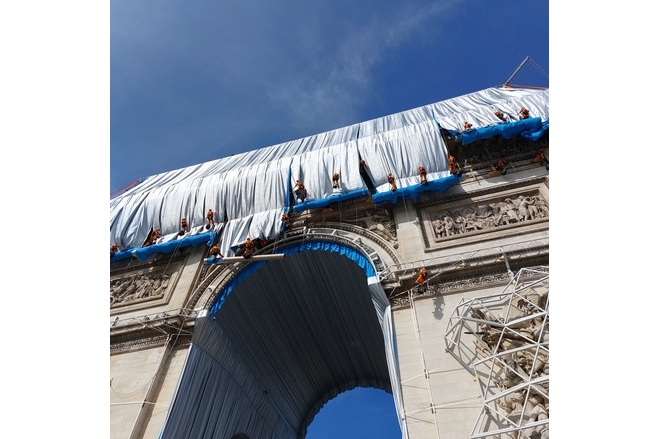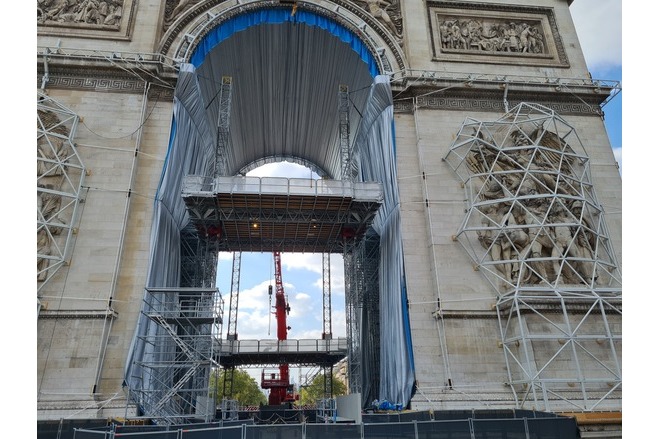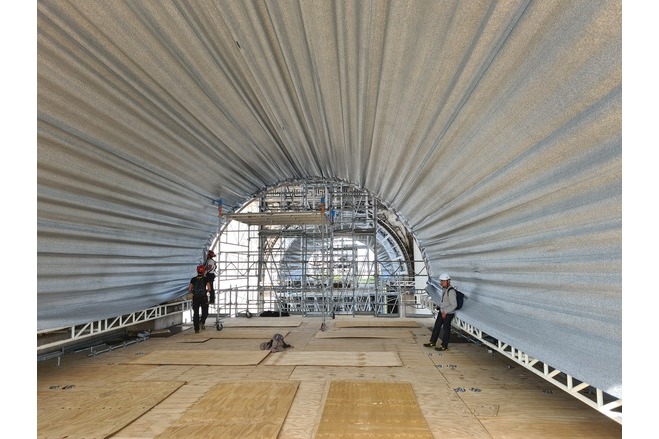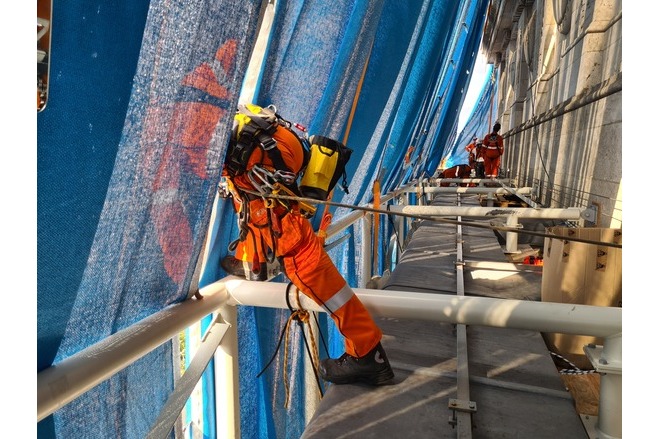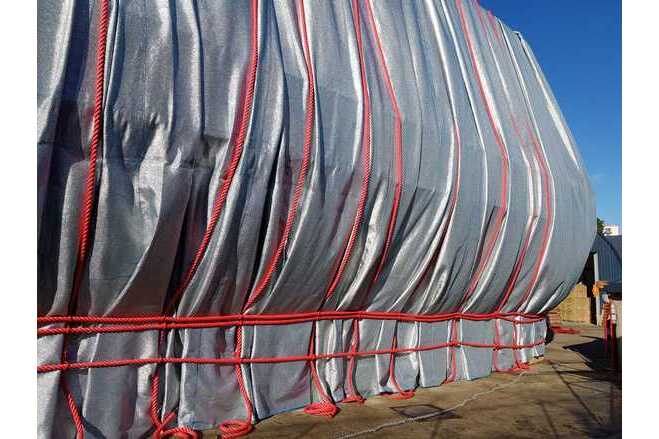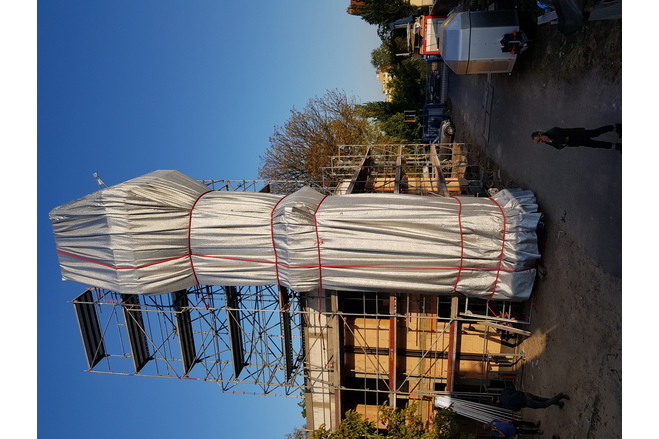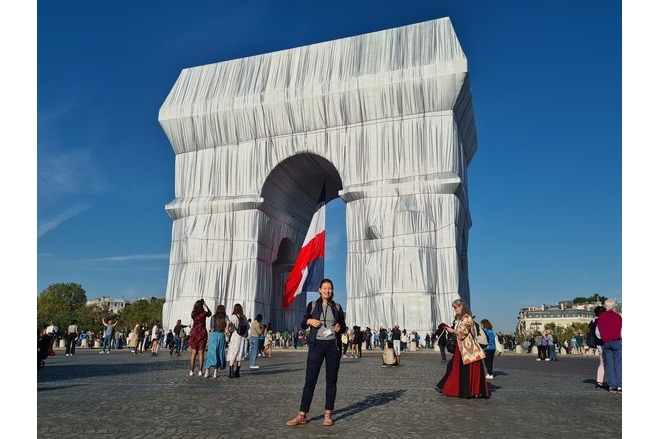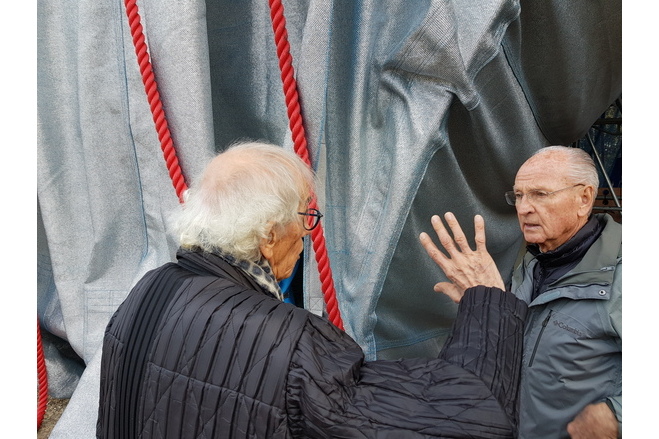L’Arc de Triomphe, Wrapped
General information
-
Location address
Paris
-
Location country
France
-
Year of construction
2021
-
Short description of the replacement or dismantling
Dismanteld
The art project L'Arc de Triomphe, Wrapped, was only on view for 16 days from September 18th to October 3rd 2021. -
Name of the client/building owner
CVJ CORPORATION
- Function of building
-
Number of layers
mono-layer
-
Type of application of the membrane
covering
Description
Start of the realization phase of the project began in September 2019 with the design and construction of a large-scale mock-up. The Installation of the project “L’Arc de Triomphe, Wrapped” was scheduled for September 2020. Based on this mock-up, Christo decided the colour of the fabric (type of blue) and the number and diameter of the red ropes.
Büro für leichtbau (bfl) developed the tensioning system for the fabric in the vaults and designed the configuration of the steel pipes for the tensioning of the vault and façade panels at the front edge of the vaults. A vault tensioning test was made in Lübeck at “geo die Luftwerker” to check that the fabric is really horizontal tensioned for the 23m free span.
Based on the hullgeometry of Christos drawings, the position of linear steel pipes is defined. Sbp developed and analysed the support structure for these pipes and their anchoring on the Arc as well as the 4 steel cages on the main façades. Then bfl analysed the stress in the fabric, the red ropes and the textile shackles for the fixing at the supporting structure behind the fabric based on the wind tunnel test report of Wacker Ingenieure. The fabric details were tested in the Lab of DEKRA, Stuttgart. Special brackets and clamps were designed and produced for the testing.
Bfl developed the folding and cutting patterns for the fabric as well as the fixings of the fabric on the roof and the façade. They used the same anchoring system on the base as on Christo’s “Wrapped Reichstag” project adapted to the special situation with the stone bench. They managed the flow of material, which were needed for the manufacturing.
Bfl made all the tests for the elongation parameters of the fabric inhouse and for the red ropes in a factory of Arnegger GmbH. They clarified with Christo the final position of the vertical and tensioned horizontal red ropes based on the geometry of the cages. A 1:3 corner mock-up was built in Berlin at Gerüstbau Tisch GmbH to check the details at the corner with the type of patterning based on a 1:20 mock-up built in the bfl office in Radolfzell.
At the end of April 2020 Christo decided cause of the Covid situation to shift the installation to September 2021. In May 2021 Christo passed away. Bfl supervised the folding and rolling process and preparing the fabric for the installation at “geo die Luftwerker” near Lübeck. An installation test with unrolling of the fabric were made with the Installation company JADE in the industrial climber trainings areal in Dunkerque. Bfl introduced JADE in the installation process based on the experience of the “Wrapped Reichstag” project.
Artist: Christo and Jeanne-Claude and nephew Vladimir Yavachev
Multi-disciplinary engineering: büro für leichtbau
Consulting engineer for steel support structure: sbp
Windtunneltests: Wacker Ingenieure
Firetestinglab: Prüfinstitut Hoch
Fabric details testing for tensile strength: Dekra
Textile rope, textile shackles, splices and further details testing for tensile strength: Gleistein
Supplier for wooden construction, installer for wooden and steel construction, workshop drawings for wood and steel: Les Charpentiers des Paris
Supplier of steel structure: Canametal
Supplier of steel ballast: ArcelorMittal
Installation of tensioned steel cables below Grande Corniche: Freyssinet
Installation unrolling fabric outer façade and installation of red ropes: JADE
Recycling of fabric: yarn producer Saxa Syntape; Head of Parley
Recycling of red rope: Atmos
Facts and figures on the material:
Yarn for weaving by Saxa Syntape GmbH
Woven fabric of blue (pantone 3005C) and grey polypropylene (fire retardant B1); width 1,62m by Setex Textil GmbH
Aluminium for metallisation of the fabric, coated with thin aluminium layer via thermal evaporation by Rowo-Coating
Fabric panels: 40 pieces made of 432 strips
Sewing seams: 104km; sewed with 440km thread by Gütermann GmbH
Red polypropylene rope with diameter of 36mm; 3km red rope by Gleistein and Trenčín
Oher ropes, cords and strings: 12,8km by Gleistein and Trenčín
Red rope crossing clamps: 263 pieces holded back with textile dyneema shackles by Gleistein and Trenčín
88 thimbles for horizontal 36mm ropes by Friedrich Höppe GmbH
Ratchet Belts: 2616 pieces by Dolezych
Woven belts: 5,2km by Güth&Wolf
Woven loop webbing: 6,7km by Bowmer Bond Narrow Fabrics Ltd
Fabric reinforcements: 969m² PVC-coated Polyester fabric, Type 5 by Verseidag and Serge Ferrari
Description of the environmental conditions
Material of the cover
-
Cable-net/Fabric/Hybrid/Foil
Fabric
Main dimensions and form
-
Covered surface (m2)
25000
Duration of use
-
Temporary or permanent structure
Temporary
Involved companies
-
Engineers
büro für leichtbau
Editor
-
Editor
Evi Corne


